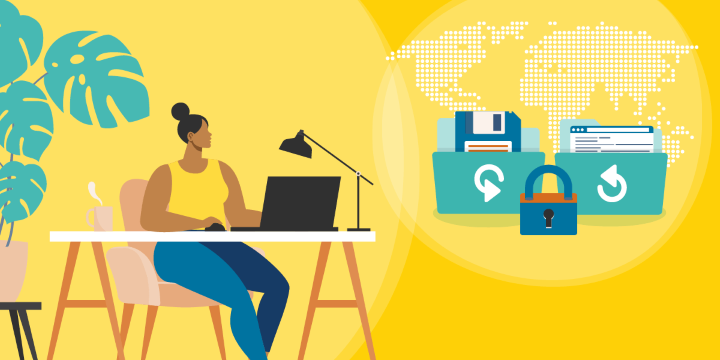Even with preventive measures in place, any organization can fall victim to data loss, through a cyberattack, system failure, or natural disaster. For this reason, it is vital that you have a disaster recovery plan, which includes having multiple backups of all your important data.
The prospect of preparing for the worst can be overwhelming. Here's some guidance to help you create your data backup and recovery plan, from storing your data to recovering a backup after a data breach.

Configuring Your Backup
Creating backups is a strategic and ongoing process. As an industry standard, you'll want to follow the 3-2-1 rule when configuring your data backups. Following this rule, you'll have three separate copies of your data, on at least two different mediums, at least one of which should be offsite. For example, you might use an internal and external hard drive, or a physical copy along with a cloud backup. For data that isn't time-sensitive, a physical copy on a USB or hard drive can be a good measure to take.
One of the most important best practices when backing up your data is to do it regularly. Many nonprofits will suffer a cyberattack or other disaster that results in data loss, only to find that their most recent backup was weeks or even months ago. Depending on the nature of your work, losing a month's worth of data or more could be devastating, impacting your ability to serve your community.
Finding the Right Tech
In order to help you ensure that you've always got a recent backup, you can invest in data backup and recovery technology that will automatically save regular copies of your files. Veritas Backup Exec, for example, will automatically create copies of your data, storing them in physical or virtual environments. In the event of a disaster, Backup Exec can restore an entire server in minutes, whether it's to the same devices or different ones.
You can also take advantage of cloud document storage systems like Google Drive, Box, or Dropbox that allow you to easily store and recover your files. Just make sure that you have the relevant security features and add-ons for the backup tool you use; otherwise your cloud backups can be vulnerable to ransomware encryption. To use these tools as a data backup system, you'll need to set the app to continually sync to your device. The process for doing this depends slightly on the app, but some, such as Dropbox, have a dedicated backup feature. In Google Drive, you can enable a two-way backup by turning on automatic sync. This not only backs up the contents of your hard drive to Google Drive but also ensures that any files living in your drive are copied to your computer. This means that if you ever lose access to your Google Drive account or the data in the account is compromised, you won't lose your files.
Restoring Your Files
The way in which you'll restore your files to your devices depends on the method you used to back them up. If you're restoring files from a USB or hard drive, for example, you'll need to plug it into a computer and copy the relevant files over. Restoring from a Google Drive or other cloud backup simply involves downloading the files you need.
While this manual recovery process can be effective, you can save yourself time and provide peace of mind by using a tool like Veritas System Recovery if you have experience with system administration. System Recovery allows you to schedule recovery points to be created at regular intervals and to browse the recovery point for certain files, messages, or documents. It also supports secondary backup locations, which will be essential if your primary backup location becomes inaccessible.
If you're unsure which Veritas product is a better option for your nonprofit, our comparison guide to the two tools might help.
Getting Prepared
Cybersecurity risks are real, and without a robust backup strategy, a significant data loss could be devastating for your organization. In order to minimize downtime and keep your operations running, you should ensure that you are regularly backing up your files using the 3-2-1 rule. You should also train your team in both how to prevent cyberattacks and data loss, and what to do in case of a disaster. This will help to ensure that your nonprofit is able to stay up and running in the face of these threats and continue to serve the communities that need you.
Additional Resources
- Take TechSoup Courses' series on Disaster Preparedness for Nonprofit Organizations.
- Get the details on How to Renew Your Backup Exec Licensing.
- See how Veritas has supported many organizations in accomplishing their missions.
- See how TechSoup's Managed IT Services might help keep your data protected.
Top photo: Shutterstock







